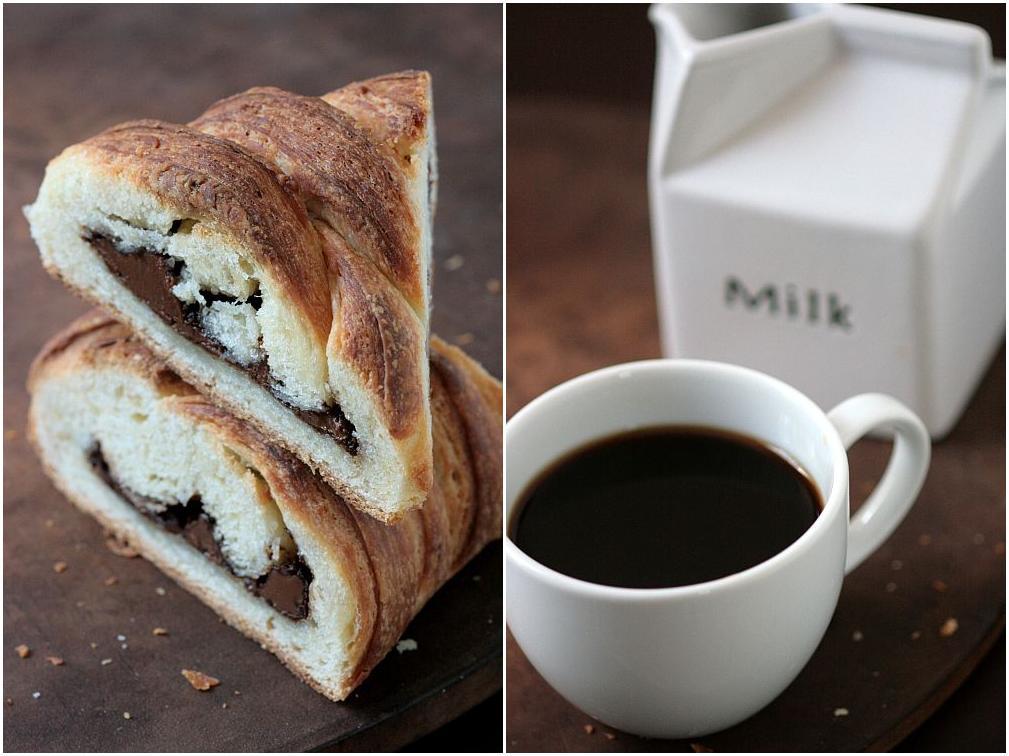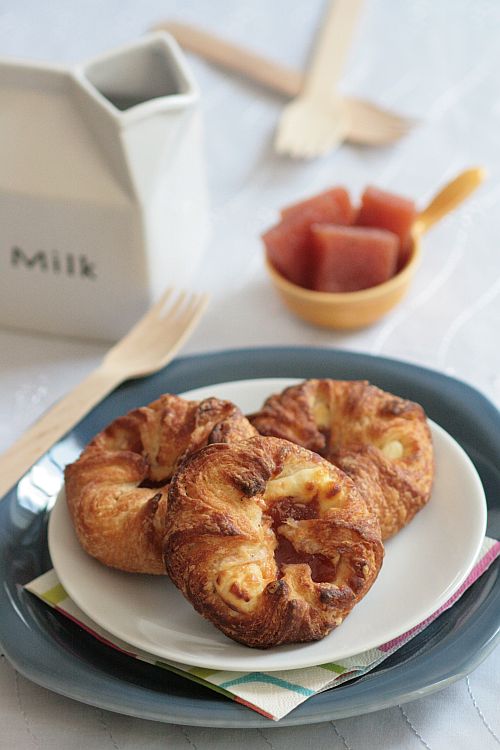
Quickly after they posted the recipe inspired by Sherry Yard, The Secrets Of Baking, my mother-in-law was hosting her garden club and since I usually provide these ladies with some sort of baked goods, I thought of doing a half batch of the braid. Then a few days later, my Bakenistas and I met on Skype on Sunday morning and made a full batch. I had worked an overnight at the restaurant and I had started the dough there on my break. I arrived right on time to meet up with Lisa, Ivonne, Mary, Kelly, Ben, Chris and John. Same rowdy bunch, same coffee spillage laughing out loud. That batch was distributed around the neighborhood and B’s students. The weekend after that, he gave me a pity party for not having any left so I agreed to make another half batch. The last one? Yesterday…of all days…when I could not retrieve my Danish Braid picture folder and sent a screeching help email to whomever could help. Thank you John for the programs because they obviously work….and I can write this post eating a slice of Danish without freaking out or melting down.
Summary? Well, we have one Nutella filled Danish Braid, one Blackberry Cream Cheese Braid with Almond Streudel Topping, a few Quince Danishes (thanks to Marcela who brought me a huge can of quince paste from Argentina, 2 pounds of it!), a few Loquat Jam filled Danishes.
Basically, I’d be lying if I told you that we did not enjoy it or that I did not find it a breeze to work with…even in the heat we are having and all the humidity. I do admit that I have a secret (well, not anymore) weapon when it comes to rolling laminated dough like danishes or puff pastry in the summer in South Carolina: a pastry board with ice pack inserts, which you can see see here.
For the filings I spooned Nutella right from the jar and the loquat jam was spread the same way, from the jar. For the blackberry filled braid, I simply cooked some berries with sugar and spooned 4 oz of cream cheese mixed with 2 Tb of sugar on the dough before the blackberries. For the quince paste, I did put a small spoonfull of mascarpone before the paste in the danish. No real recipes, just trying what I have on hand.Kelly and Ben provided a wonderful apple filling recipe for the braid but I had to make room in the fridge and not very much time to do it, but I have it bookmarked for this winter. One other thing: I skipped the egg wash and just sprayed the braids and danishes with some water before baking, to keep the layers light and crispy during baking.
Danish Braid, inspired by Sherry Yard, The Secrets of Baking:
Makes 2-1/2 pounds dough
For the dough (Detrempe)
1 ounce fresh yeast or 1 tablespoon active dry yeast
1/2 cup whole milk
1/3 cup sugar
Zest of 1 orange, finely grated
3/4 teaspoon ground cardamom
1-1/2 teaspoons vanilla extract
1/2 vanilla bean, split and scraped
2 large eggs, chilled
1/4 cup fresh orange juice
3-1/4 cups all-purpose flour
1 teaspoon salt
For the butter block (Beurrage)
1/2 pound (2 sticks) cold unsalted butter
1/4 cup all-purpose flour
Dough:Combine yeast and milk in the bowl of a mixer fitted with the paddle attachment and mix on low speed. Slowly add sugar, orange zest, cardamom, vanilla extract, vanilla seeds, eggs, and orange juice. Mix well. Change to the dough hook and add the salt with the flour, 1 cup at a time, increasing speed to medium as the flour is incorporated. Knead the dough for about 5 minutes, or until smooth. You may need to add a little more flour if it is sticky. Transfer dough to a lightly floured baking sheet and cover with plastic wrap. Refrigerate for 30 minutes.
Without a standing mixer: Combine yeast and milk in a bowl with a hand mixer on low speed or a whisk. Add sugar, orange zest, cardamom, vanilla extract, vanilla seeds, eggs, and orange juice and mix well. Sift flour and salt on your working surface and make a fountain. Make sure that the “walls” of your fountain are thick and even. Pour the liquid in the middle of the fountain. With your fingertips, mix the liquid and the flour starting from the middle of the fountain, slowly working towards the edges. When the ingredients have been incorporated start kneading the dough with the heel of your hands until it becomes smooth and easy to work with, around 5 to 7 minutes. You might need to add more flour if the dough is sticky.
Butter block: Combine butter and flour in the bowl of a mixer fitted with a paddle attachment and beat on medium speed for 1 minute. Scrape down the sides of the bowl and the paddle and then beat for 1 minute more, or until smooth and lump free. Set aside at room temperature.
– After the detrempe has chilled 30 minutes, turn it out onto a lightly floured surface. Roll the dough into a rectangle approximately 18 x 13 inches and ¼ inch thick. The dough may be sticky, so keep dusting it lightly with flour. Spread the butter evenly over the center and right thirds of the dough. Fold the left edge of the detrempe to the right, covering half of the butter. Fold the right third of the rectangle over the center third. The first turn has now been completed. Mark the dough by poking it with your finger to keep track of your turns, or use a sticky and keep a tally. Place the dough on a baking sheet, wrap it in plastic wrap, and refrigerate for 30 minutes. – Place the dough lengthwise on a floured work surface. The open ends should be to your right and left. Roll the dough into another approximately 13 x 18 inch, ¼-inch-thick rectangle. Again, fold the left third of the rectangle over the center third and the right third over the center third. No additional butter will be added as it is already in the dough. The second turn has now been completed. Refrigerate the dough for 30 minutes.
– Roll out, turn, and refrigerate the dough two more times, for a total of four single turns. Make sure you are keeping track of your turns. Refrigerate the dough after the final turn for at least 5 hours or overnight. The Danish dough is now ready to be used. If you will not be using the dough within 24 hours, freeze it. To do this, roll the dough out to about 1 inch in thickness, wrap tightly in plastic wrap, and freeze. Defrost the dough slowly in the refrigerator for easiest handling. Danish dough will keep in the freezer for up to 1 month.
Danish Braid:
Makes enough for 2 large braids
1 recipe Danish Dough
filling of your choice
– Line a baking sheet with a silicone mat or parchment paper. On a lightly floured surface, roll the Danish Dough into a 15 x 20-inch rectangle, ¼ inch thick. If the dough seems elastic and shrinks back when rolled, let it rest for a few minutes, then roll again. Place the dough on the baking sheet.
– Along one long side of the pastry make parallel, 5-inch-long cuts with a knife or rolling pastry wheel, each about 1 inch apart. Repeat on the opposite side, making sure to line up the cuts with those you’ve already made.
– Spoon the filling you’ve chosen to fill your braid down the center of the rectangle. Starting with the top and bottom “flaps”, fold the top flap down over the filling to cover. Next, fold the bottom “flap” up to cover filling. This helps keep the braid neat and helps to hold in the filling. Now begin folding the cut side strips of dough over the filling, alternating first left, then right, left, right, until finished. Trim any excess dough and tuck in the ends.
Proofing and Baking
– Spray cooking oil (Pam…) onto a piece of plastic wrap, and place over the braid. Proof at room temperature or, if possible, in a controlled 90 degree F environment for about 2 hours, or until doubled in volume and light to the touch.
– Near the end of proofing, preheat oven to 400 degrees F. Position a rack in the center of the oven.
– Bake for 10 minutes, then rotate the pan so that the side of the braid previously in the back of the oven is now in the front. Lower the oven temperature to 350 degrees F, and bake about 15-20 minutes more, or until golden brown. Cool and serve the braid either still warm from the oven or at room temperature. The cooled braid can be wrapped airtight and stored in the refrigerator for up to 2 days, or freeze for 1 month.



